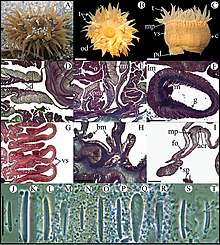Bunodosoma cavernatum
Bunodosoma cavernatum, commonly known as the warty sea anemone[2] or the American warty anemone,[3] is a species of sea anemone in the family Actiniidae. It occurs in the tropical and subtropical western Atlantic Ocean and the Caribbean Sea. It was first described in 1802 by the French naturalist Louis Augustin Guillaume Bosc, one of fourteen marine invertebrates described and named by him.[4]
| Bunodosoma cavernatum | |
|---|---|
| Scientific classification | |
| Kingdom: | Animalia |
| Phylum: | Cnidaria |
| Class: | Anthozoa |
| Order: | Actiniaria |
| Family: | Actiniidae |
| Genus: | Bunodosoma |
| Species: | B. cavernatum |
| Binomial name | |
| Bunodosoma cavernatum | |
| Synonyms[1] | |
| |
Description

A. Live specimen in natural habitat,
B. Oral view, C. Lateral view,
D.-I. Sections, J.–T. Cnidae
Bunodosoma cavernatum is a robust species with a muscular trunk covered with 96 vertical rows of small, rounded, wart-like vesicles. The oral disc is smooth and the approximately 96 tentacles are arranged in five cycles. Each tentacle is of moderate length, smooth and tapering, the inner tentacles being longer than the outer ones. At their base are about 48 rounded lobular projections called acrorhagi which are armed with stinging cells.[5]
The colour of the trunk varies, being some shade of olive green, orange, red or brown. The tentacles are olive green, pale orange or reddish, with the oral disc being yellowish-brown, reddish-brown or olive green, sometimes with faint pale radial striping. When fully extended this sea anemone can reach 15 mm (0.6 in) in height, and the tentacles and oral disc when extended can reach 40 mm (1.6 in) in diameter.[5]
Distribution and habitat
Bunodosoma cavernatum is native to the tropical and subtropical western Atlantic Ocean and the Caribbean Sea, its range extending from North Carolina to Texas, including Florida and the West Indies. It occurs in the lower part of the intertidal zone on rocks and jetties, and on other hard substrates underlying gravelly or sandy bottoms.[3]
Ecology
Bunodosoma cavernatum is nocturnal; during the night it expands and spreads out its tentacles to feed but during the day, it contracts into a reddish gelatinous blob.[2] It feeds on small fish and any invertebrates that are encountered by its tentacles. The remains of a scorched mussel (Brachidontes exustus) have been found inside one individual.[3]
References
- Fautin, Daphne (2018). "Bunodosoma cavernatum (Bosc, 1802)". WoRMS. World Register of Marine Species. Retrieved 16 September 2018.
- Voss, Gilbert L. (2013). Seashore Life of Florida and the Caribbean. Courier Corporation. pp. 44–45. ISBN 978-0-486-16603-2.
- Sept, J. Duane (2016). Atlantic Seashore Field Guide: Florida to Canada. Stackpole Books. pp. 29–30. ISBN 978-0-8117-6348-6.
- Sanders, Albert E.; Anderson, William Dewey (1999). Natural History Investigations in South Carolina: From Colonial Times to the Present. Univ of South Carolina Press. p. 309. ISBN 978-1-57003-278-3.
- González-Muñoz, Ricardo; Simões, Nuno; Tello-Musi, José Luis; Rodríguez, Estefanía (2013). "Sea anemones (Cnidaria, Anthozoa, Actiniaria) from coral reefs in the southern Gulf of Mexico". ZooKeys. 341: 77–106. doi:10.3897/zookeys.341.5816. PMC 3800810.